 The Clinical Neuropsychiatry of Stroke
The Clinical Neuropsychiatry of Stroke Book contents
- Frontmatter
- Contents
- Preface
- Part I Introduction
- Part II Poststroke depression
- 5 Diagnosis of depression
- 6 Prevalence of depressive disorders
- 7 Phenomenology and specificity of depressive symptoms
- 8 Natural course of depression
- 9 Delayed-onset depression
- 10 Relationship to lesion location
- 11 Relationship of depression to cerebral dominance and structural asymmetries
- 12 Relationship of depression to bilateral hemisphere brain injury
- 13 Relationship of depression to physical impairment
- 14 Relationship to cognitive impairment and treatment
- 15 Relationship of aphasia to depression
- 16 Relationship of depression to social functioning
- 17 Relationship to premorbid risk factors
- 18 Mortality and treatment
- 19 Suicidal thoughts and plans
- 20 Biological markers
- 21 Mechanisms of poststroke depression
- 22 Treatment of poststroke depression
- 23 Prevention of poststroke depression
- Part III Poststroke mania
- Part IV Poststroke anxiety disorders
- Part V Other poststroke disorders
- Index
13 - Relationship of depression to physical impairment
from Part II - Poststroke depression
Published online by Cambridge University Press: 01 October 2009
- Frontmatter
- Contents
- Preface
- Part I Introduction
- Part II Poststroke depression
- 5 Diagnosis of depression
- 6 Prevalence of depressive disorders
- 7 Phenomenology and specificity of depressive symptoms
- 8 Natural course of depression
- 9 Delayed-onset depression
- 10 Relationship to lesion location
- 11 Relationship of depression to cerebral dominance and structural asymmetries
- 12 Relationship of depression to bilateral hemisphere brain injury
- 13 Relationship of depression to physical impairment
- 14 Relationship to cognitive impairment and treatment
- 15 Relationship of aphasia to depression
- 16 Relationship of depression to social functioning
- 17 Relationship to premorbid risk factors
- 18 Mortality and treatment
- 19 Suicidal thoughts and plans
- 20 Biological markers
- 21 Mechanisms of poststroke depression
- 22 Treatment of poststroke depression
- 23 Prevention of poststroke depression
- Part III Poststroke mania
- Part IV Poststroke anxiety disorders
- Part V Other poststroke disorders
- Index
Summary
Background
Apart from studies of the prevalence of poststroke depression, more investigators have examined the relationship between depression and physical impairment than any other association. Perhaps it is an understandable interest because motor impairment represents the most common presenting symptom among patients admitted to hospital with an acute stroke; approximately 70–80% of patients with acute hemispheric stroke present with weakness or paralysis of either the upper and/or lower extremity. Compared with other neurological impairments produced by stroke, such as sensory loss which occurs in about 35% of patients with hemispheric stroke or visual field loss which occurs in about 20%, hemiparesis or monoparesis occurs in the majority of patients admitted to hospital with acute stroke.
Although there is an initial tendency to assume that there is an understandable relationship between poststroke depression and physical impairment, the existing evidence suggests that the relationship is a complex one in which the severity of depressive disorder affects the severity and recovery of physical impairment, and the severity of physical impairment affects the severity and course of depression. In addition, there appear to be dynamic changes over time in the relationship between depression and physical impairment. Using the large database which examined the prevalence of depressive disorders (see Chapter 6), I have summarized the world's literature in Table 13.1 which allows findings from various studies to be compared and readers who are interested in investigating specific studies to identify these studies.
- Type
- Chapter
- Information
- The Clinical Neuropsychiatry of StrokeCognitive, Behavioral and Emotional Disorders following Vascular Brain Injury, pp. 125 - 147Publisher: Cambridge University PressPrint publication year: 2006


